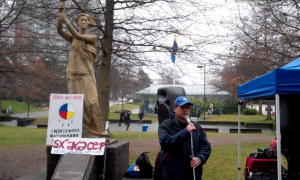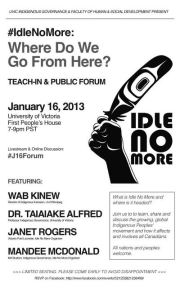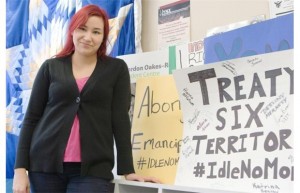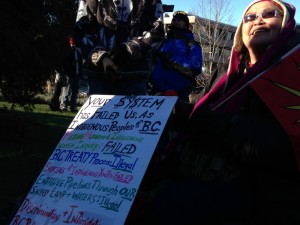Thank you to Idle No More student planners of the extremely important demonstration at the University of British Columbia yesterday (31 January). This was the first of many to come at a University that has grown irresponsible in its expansion throughout the unceded Musqueam territory on which it is settled. This was a refreshingly catalytic exploration of the varied and complex issues represented within the Idle No More movement for a campus waking up from a decade of messages from the University that an inactive and idle student body is the best student body.
The Idle No More Teach-In at UBC this afternoon at the First Nations Longhouse will work from yesterday’s demonstration to generate next steps for this decreasingly idyllic, but no longer idle, campus.
Most videos from the Idle No More Demonstration at UBC (31 January 2013) are accessible:
- Mike Dangeli, Goothl Ts’imilx First Nation, acknowledges Musqueam territory, and welcomes #IdleNoMore demonstrators at the University of British Columbia with words of wisdom and victory song (31 January 2013)
- Victor Guerin, Coast Salish First Nation, reminds #IdleNoMore demonstrators that the University of British Columbia is on unceded Musqueam territory, and welcomes with caution and wisdom (31 January 2013)
- Lee Brown, Cherokee Nation and Wolf Clan and Director of the Institute for Aboriginal Health, speaks truth, wisdom, and responsibility to power at the #IdleNoMore demonstration at the University of British Columbia (31 January 2013)
- Karina Czyzewski, graduate student in Social Work, speaks on the truth of anti-racist and anti-oppressive relations with First Nations, at the #IdleNoMore demonstration at the University of British Columbia (31 January 2013)
- Shannon Hecker, graduate student in First Nations Studies, speaks on the truth of anti-racist and anti-oppressive relations with First Nations, at the #IdleNoMore demonstration at the University of British Columbia (31 January 2013)
- Charles Menzies, Gitxaala First Nation and Professor of Anthropology, speaks on the urgency and relevance of #IdleNoMore to environmental and indigenous rights and justice (31 January 2013)
- Coll Thrush, Professor of History, speaks as an advocate of #IdleNoMore at a demonstration at the University of British Columbia (31 January 2013).


 Follow
Follow


